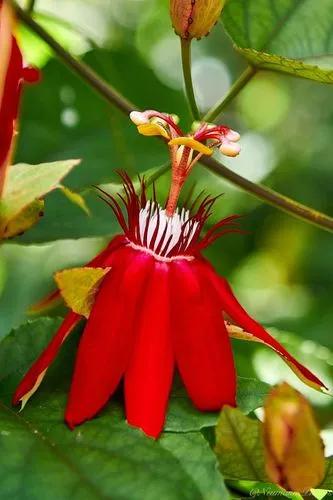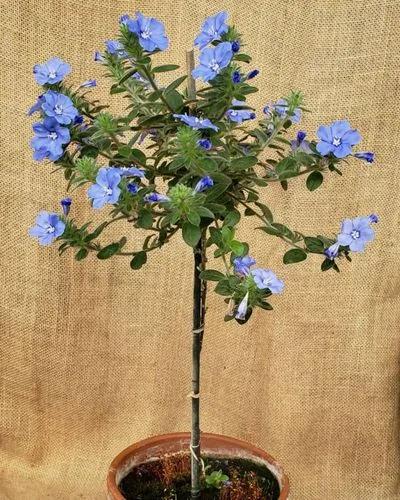Calceolaria, also known as the Pocketbook Plant, is admired for its distinctive pouched flowers that resemble pocketbooks or slippers. This annual plant thrives in cool environments with moderate light. Although it can be demanding to care for, the beauty of the Lady Purse plant makes it worthwhile. It is a popular choice for indoor gardens due to its small size and suitability for pots while also adding vibrant colors to outdoor garden beds and borders.
Calceolaria Care
Calceolaria herbeohybrida
Other names: Slipperwort, Lady’s Purse, Slipper Flower, Pocketbook Flower, Pouch, Calceolaria Crenatiflora, Calceolaria Multiflora



Calceolaria plants are known for their stunning pouch-shaped blooms that grow in clusters on tall stems. The plant's main identification feature is the heart-shaped leaves, with scalloped edges and deep veins. The bloom time typically occurs in spring and summer, showcasing vibrant colors such as yellow, red, maroon, and pink, often with unique spots or patterns. These flowers can be found as both perennial and annual varieties, originating from Chile and South America. The plant's height and width can vary, ranging from 3 to 36 inches (7.5-90 cm) tall and 8 to 20 inches (20-50 cm) wide, depending on the variety. The foliage is characterized by dark green crinkly leaves, and the flowers appear in loose clusters with pouch-like or slipper-like shapes.
How to Care for the Plant

Water

To maintain healthy moisture levels, ensure the soil is consistently but lightly moist. Avoid letting the soil dry out completely, as it may hinder the plant's recovery. Use pots with drainage holes and water thoroughly, making sure to wet all the roots before emptying the drainage tray. Be cautious not to water over the plant's crown to prevent rot. Watering in the morning allows the leaves to dry before darkness sets in, further preventing leaf issues.

Pruning

You don't really have to worry about pruning. Just keep an eye out for any damaged leaves or faded flowers and remove them as needed. With proper care, your Calceolaria should bloom for about a month. You can pinch back the flowers if you want to maintain its shape and make the blooms last longer.

Fertilizer

Pocketbook Plant does not require frequent fertilization. You can feed the plant once a month during the growing season using a houseplant fertilizer or a general-purpose garden fertilizer. Opt for a fertilizer designed for annuals if available. Check the product instructions for the recommended amount and frequency.

Sunlight

Find a spot for your flower to soak up some bright light, but shield it from that scorching direct sunlight. If you've got a window that's all about that intense southern exposure, hang up a sheer curtain to soften the rays. For a cozier vibe, try a northern window or a spot that's not directly in the light's path. Calceolaria loves basking in the sun for around six to seven hours a day, but it's chill with a little shade in the morning and some sunny afternoons.

Soil

For optimal growth, choose a loose and fertile soil mix. It can consist of a peat moss-based potting mix combined with compost, sand, perlite, or a combination of these substrates. It's important to ensure the soil is well-drained to prevent issues like root rot. Adding organic matter like compost or well-rotted manure will supply the necessary nutrients for the plants to thrive.

Propagation

Propagating pocketbook plants can be challenging, whether through cuttings or seeds. If you choose to grow from seeds, sow them in June or July in a tray with a transparent lid, using a mixture of potting soil, peat moss, and coarse sand. Keep the soil moist and maintain a temperature of around 65°F (18°C). Germination usually takes two to three weeks. Once the seedlings reach the lid, transplant them to separate pots. The young plants should be kept above 43°F (6°C) during the winter to ensure their survival.

Temperature

Lady's Purse thrives in cool temperatures, preferring night temperatures of 45-50°F (7-10°C) and day temperatures of 55-60°F (13-16°C). It grows best in USDA hardiness zones 10 to 11 and is typically treated as an annual, discarding it after flowering. To encourage fuller blooms, maintain temperatures around 60-65°F (15-18°C). While it can tolerate a range of temperatures, it should be protected from frost, with temperatures below freezing prompting the need to move it indoors.

Container

Pocketbook Plant doesn't have any special container requirements. Some people even grow it in pots they bought it in; thus, make sure the container has drainage holes, and the rest will be okay.

Fun fact

Calceolaria, also known as Lady's Purse, Slipper Flower, or Slipperwort, encompasses a diverse range of over 380 plant species, including shrubs and herbs from the genus Calceolaria (Calceolariaceae). The plant is recognized for its distinctive rounded flower shape and has acquired different common names reflecting this feature.

Popularity

48 people already have this plant 28 people have added this plant to their wishlists
Discover more plants with the list below
Popular articles






